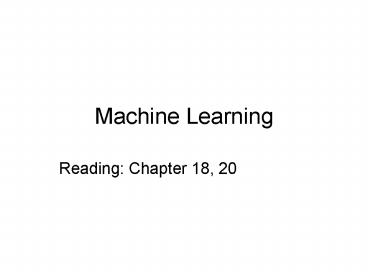Machine Learning - PowerPoint PPT Presentation
1 / 21
Title:
Machine Learning
Description:
P(D|h) = probability of observing data D given some world where hypothesis holds ... Just as in the KDD Cup example. Feature selection is required on your homework. 18 ... – PowerPoint PPT presentation
Number of Views:34
Avg rating:3.0/5.0
Title: Machine Learning
1
Machine Learning
- Reading Chapter 18, 20
2
Agenda
- Naïve Bayes
- Feature Selection
- An example problem
- Census Data
- Weka Tutorial
- The Homework
3
Classification Task
- Input instance
- Tuple of attribute values lta1,a2,angt
- Output class
- Any value hi from finite set H
- Given a training set of instances, predict class
of new instance
4
Examples
- H setosa, verginica, versicolour
- Input instance
- lts-length7, p-width3, p-length 4gt
- Instance Representation lt7,3,4gt
- Data Representation
- 7 3 4
- 10 2 1
- 5 6 2
- H lt50, between 50 and 100, gt 100
- Input instance
- ltauthor, abstract, title, journalgt
- Instance representation ltSmith, John, We
showed that , Brane New World, HEP1gt - Note difference in strings vs. categorical values
5
Bayesian Approach
- Each observed training example can incrementally
decrease or increase probability of hypothesis
instead of eliminate an hypothesis - Prior knowledge can be combined with observed
data to determine hypothesis - Bayesian methods can accommodate hypotheses that
make probabilistic predictions - New instances can be classified by combining the
predictions of multiple hypotheses, weighted by
their probabilities
6
Applying Bayes Theorem
- Best hypothesis most probable hypothesis
- Maximum a posteriori (MAP) hypothesis
- Variables
- h hypothesis
- D data
- Prior probability
- h P(h)
- training data observed P(D)
- P(Dh) probability of observing data D given
some world where hypothesis holds - Bayes theorem
- P(hD) P(Dh)P(h) P(D)
7
Defining the MAP hypothesis
- hMAPargmax P(hD) heH
- hMAPargmax P(Dh)P(h) heH
P(D) - (Using Bayes Theorem)
- hMAPargmax P(Dh)P(h) heH
(P(D) is a constant independent of h) - hMAPargmax P(Dh) heH(when we can
make the assumption that each hypothesis h is
equally probable)
8
Bayes Optimal Classifier
- The most probable classification of the new
instance by combining the predictions of all
hypotheses weighted by their posterior
probabilities - Possible classifications vjeV
- Argmax ? P(vjhi)P(hiD) vjeV hieH
9
Example
- V p, n
- P(h1D).4 P(ph1)0 P(n,h1)1
- P(h2D).3 P(ph2)1 P(n,h2)0
- P(h3D).3 P(ph3)1 P(n,h3)0
- ? P(nhi)P(hiD) .4hieH
- ? P(phi)P(hiD) .6
- hieH
- Argmax ? P(vjhi)P(hiD) p
- vjep,n hieH
10
Properties of Bayesian Approach
- Bayesian learning is optimal
- Easy to estimate P(h) by counting in training
data - Estimating P(Dh) not feasible
- Why?
11
P(Dh)
12
Naïve Bayes
- Assume independence of attributes
- D a1,a2,an
- P(a1,a2,anvj)?P(aivj)
i - Substitute into VMAP formula
- VNBargmax P(vj)?P(aivj) vj?V
i
13
VNBargmax P(vj)?P(aivj) vj?V
14
Estimating Probabilities
- What happens when the number of data elements is
small? - Suppose true P(S-lengthhighverginica).05
- There are only 2 instances with CVerginica
- We estimate probability by nc/n or
S-lengthVerginica/C-Verginica - S-lengthVerginica must 0
- Then, instead of .05 we use estimated probability
of 0 - Two problems
- Biased underestimate of probability
- This probability term will dominate
15
Instead
- Use priors as well
- ncmp nm
- Where p prior estimate
- M is a constant called the equivalent sample size
- Determines how heavily to weight p relative to
observed data - Typical method assume a uniform prior
16
Benefits of Naïve Bayes
- Practical
- As effective and in some cases, more so, than
other machine learners
17
Feature Selection
- Can be used with any machine learning algorithm
- Experimentally determine which attribute(s) helps
learning most - Just as in the KDD Cup example
- Feature selection is required on your homework
18
Algorithm for feature selection
- Forward selection
- Incrementally add one attribute at a time
- Train on training data (1/3 of the data)
- Test on validation data (1/3) of the data)
whether the current set of attributes gives an
improvement - When done, test full model on held-out training
data - Backwards elimination
19
Forward Feature Selection
- Start with no features and greedily add the
feature that most improves performance - Given a set of n attributes, measure performance
with each attribute alone - Note that this requires n separate learning
models - Choose the best
- Now pair the best with every remaining attribute
and measure performance - Choose the best pair
- Repeat with triples, quadruples, etc. until no
improvement
20
Example Systematic exploration of attribute
combinations
- Journal article downloads
- Started with rock bottom down loads only
- Tried abstract alone, author alone
- Abstract and author together yielded better
results - Then added in-degree, out-degree
21
Feature selection
- Can be done within WEKA
- Can be done outside of WEKA
- By creating different data sets































